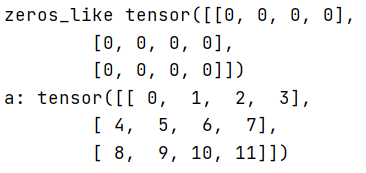tensor.item()
item()用法是:一个元素张量可以用x.item()得到元素值
zero_()、zeros()、zeros_like()
zero_():将矩阵中的元素全部变为0
>>> import torch
>>> torch.manual_seed(seed=20200910)
<torch._C.Generator object at 0x000002BCFF2CD330>
>>>
>>> a = torch.randn(3,4)
>>> b = a
>>> b
tensor([[ 0.2824, -0.3715, 0.9088, -1.7601],
[-0.1806, 2.0937, 1.0406, -1.7651],
[ 1.1216, 0.8440, 0.1783, 0.6859]])
>>> a
tensor([[ 0.2824, -0.3715, 0.9088, -1.7601],
[-0.1806, 2.0937, 1.0406, -1.7651],
[ 1.1216, 0.8440, 0.1783, 0.6859]])
>>>
>>> a.zero_()
tensor([[0., 0., 0., 0.],
[0., 0., 0., 0.],
[0., 0., 0., 0.]])
>>> a
tensor([[0., 0., 0., 0.],
[0., 0., 0., 0.],
[0., 0., 0., 0.]])
>>> b
tensor([[0., 0., 0., 0.],
[0., 0., 0., 0.],
[0., 0., 0., 0.]])
>>>
>>>
>>>
>>>
zeros():生成全零矩阵
# Importing the PyTorch library
import torch
# Applying the zeros function and
# storing the resulting tensor in 't'
a = torch.zeros([3, 4])
print("a = ", a)
输出
a = tensor([[0., 0., 0., 0.],
[0., 0., 0., 0.],
[0., 0., 0., 0.]])
zeros_like():生成一个与输入矩阵大小维度一致的全零矩阵,不改变输入矩阵的元素
import torch
if __name__ == "__main__":
a = torch.arange(12).view((3,4))
print("zeros_like",torch.zeros_like(a))
print("a:",a)

选择计算设备
.to(device) 可以指定CPU 或者GPU
device = torch.device("cuda:0" if torch.cuda.is_available() else "cpu") # 单GPU或者CPU
model.to(device)
#如果是多GPU
if torch.cuda.device_count() > 1:
model = nn.DataParallel(model,device_ids=[0,1,2])
model.to(device)
.cuda() 只能指定GPU
#指定某个GPU
os.environ['CUDA_VISIBLE_DEVICE']='1'
model.cuda()
#如果是多GPU
os.environment['CUDA_VISIBLE_DEVICES'] = '0,1,2,3'
device_ids = [0,1,2,3]
net = torch.nn.Dataparallel(net, device_ids =device_ids)
net = torch.nn.Dataparallel(net) # 默认使用所有的device_ids
net = net.cuda()
torch.max()
torch.max(a,1)返回每一行中最大值的那个元素,且返回其索引(返回最大元素在这一行的列索引)
a = torch.randn(3,3)
>>
0.2252 -0.0901 0.5663
-0.4694 0.8073 1.3596
0.1073 -0.7757 -0.8649
torch.max(a,1)
>>
(
0.5663
1.3596
0.1073
[torch.FloatTensor of size 3]
,
2
2
0
[torch.LongTensor of size 3]
)

tensor.detach()
返回一个新的tensor,从当前计算图中分离下来的,但是仍指向原变量的存放位置,不同之处只是requires_grad为false,得到的这个tensor永远不需要计算其梯度,不具有grad。
即使之后重新将它的requires_grad置为true,它也不会具有梯度grad
这样我们就会继续使用这个新的tensor进行计算,后面当我们进行反向传播时,到该调用detach()的tensor就会停止,不能再继续向前进行传播
注意:
使用detach返回的tensor和原始的tensor共同一个内存,即一个修改另一个也会跟着改变。
Variable()
它封装了Tensor,并整合了反向传播的相关实现。tensor变成variable之后才能进行反向传播求梯度。
参考博文
nllloss
torch.no_grad()
在使用pytorch时,并不是所有的操作都需要进行计算图的生成(计算过程的构建,以便梯度反向传播等操作)。而对于tensor的计算操作,默认是要进行计算图的构建的,在这种情况下,可以使用 with torch.no_grad():,强制之后的内容不进行计算图构建。
使用with torch.no_grad():
with torch.no_grad():
for data in testloader:
images, labels = data
outputs = net(images)
_, predicted = torch.max(outputs.data, 1)
total += labels.size(0)
correct += (predicted == labels).sum().item()
print('Accuracy of the network on the 10000 test images: %d %%' % (
100 * correct / total))
print(outputs)
不使用with torch.no_grad()时,此时计算结果有grad_fn=属性,表示,计算的结果在一计算图当中,可以进行梯度反传等操作。但是,两者计算的结果实际上是没有区别的。






















 2862
2862











 被折叠的 条评论
为什么被折叠?
被折叠的 条评论
为什么被折叠?








